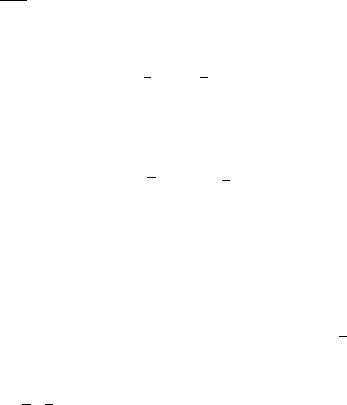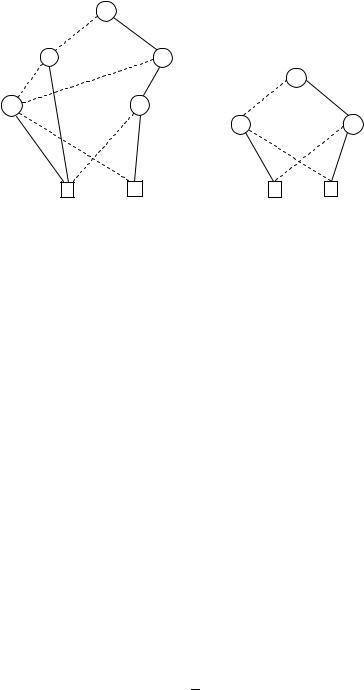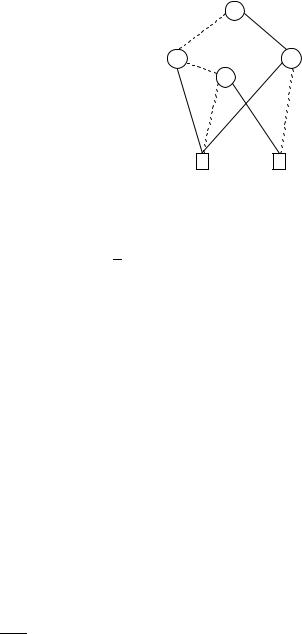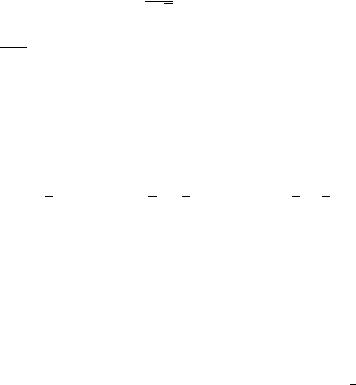
- •Contents
- •Foreword to the first edition
- •Preface to the second edition
- •Our motivation for (re)writing this book
- •What’s new and what’s gone
- •The interdependence of chapters and prerequisites
- •Acknowledgements
- •Added for second edition
- •1 Propositional logic
- •1.1 Declarative sentences
- •1.2 Natural deduction
- •1.2.1 Rules for natural deduction
- •1.2.2 Derived rules
- •1.2.3 Natural deduction in summary
- •1.2.4 Provable equivalence
- •1.2.5 An aside: proof by contradiction
- •1.3 Propositional logic as a formal language
- •1.4 Semantics of propositional logic
- •1.4.1 The meaning of logical connectives
- •1.4.2 Mathematical induction
- •1.4.3 Soundness of propositional logic
- •1.4.4 Completeness of propositional logic
- •1.5 Normal forms
- •1.5.1 Semantic equivalence, satisfiability and validity
- •1.5.2 Conjunctive normal forms and validity
- •1.5.3 Horn clauses and satisfiability
- •1.6 SAT solvers
- •1.6.1 A linear solver
- •1.6.2 A cubic solver
- •1.7 Exercises
- •1.8 Bibliographic notes
- •2 Predicate logic
- •2.1 The need for a richer language
- •2.2 Predicate logic as a formal language
- •2.2.1 Terms
- •2.2.2 Formulas
- •2.2.3 Free and bound variables
- •2.2.4 Substitution
- •2.3 Proof theory of predicate logic
- •2.3.1 Natural deduction rules
- •2.3.2 Quantifier equivalences
- •2.4 Semantics of predicate logic
- •2.4.1 Models
- •2.4.2 Semantic entailment
- •2.4.3 The semantics of equality
- •2.5 Undecidability of predicate logic
- •2.6 Expressiveness of predicate logic
- •2.6.1 Existential second-order logic
- •2.6.2 Universal second-order logic
- •2.7 Micromodels of software
- •2.7.1 State machines
- •2.7.2 Alma – re-visited
- •2.7.3 A software micromodel
- •2.8 Exercises
- •2.9 Bibliographic notes
- •3 Verification by model checking
- •3.1 Motivation for verification
- •3.2 Linear-time temporal logic
- •3.2.1 Syntax of LTL
- •3.2.2 Semantics of LTL
- •3.2.3 Practical patterns of specifications
- •3.2.4 Important equivalences between LTL formulas
- •3.2.5 Adequate sets of connectives for LTL
- •3.3 Model checking: systems, tools, properties
- •3.3.1 Example: mutual exclusion
- •3.3.2 The NuSMV model checker
- •3.3.3 Running NuSMV
- •3.3.4 Mutual exclusion revisited
- •3.3.5 The ferryman
- •3.3.6 The alternating bit protocol
- •3.4 Branching-time logic
- •3.4.1 Syntax of CTL
- •3.4.2 Semantics of computation tree logic
- •3.4.3 Practical patterns of specifications
- •3.4.4 Important equivalences between CTL formulas
- •3.4.5 Adequate sets of CTL connectives
- •3.5.1 Boolean combinations of temporal formulas in CTL
- •3.5.2 Past operators in LTL
- •3.6 Model-checking algorithms
- •3.6.1 The CTL model-checking algorithm
- •3.6.2 CTL model checking with fairness
- •3.6.3 The LTL model-checking algorithm
- •3.7 The fixed-point characterisation of CTL
- •3.7.1 Monotone functions
- •3.7.2 The correctness of SATEG
- •3.7.3 The correctness of SATEU
- •3.8 Exercises
- •3.9 Bibliographic notes
- •4 Program verification
- •4.1 Why should we specify and verify code?
- •4.2 A framework for software verification
- •4.2.1 A core programming language
- •4.2.2 Hoare triples
- •4.2.3 Partial and total correctness
- •4.2.4 Program variables and logical variables
- •4.3 Proof calculus for partial correctness
- •4.3.1 Proof rules
- •4.3.2 Proof tableaux
- •4.3.3 A case study: minimal-sum section
- •4.4 Proof calculus for total correctness
- •4.5 Programming by contract
- •4.6 Exercises
- •4.7 Bibliographic notes
- •5 Modal logics and agents
- •5.1 Modes of truth
- •5.2 Basic modal logic
- •5.2.1 Syntax
- •5.2.2 Semantics
- •Equivalences between modal formulas
- •Valid formulas
- •5.3 Logic engineering
- •5.3.1 The stock of valid formulas
- •5.3.2 Important properties of the accessibility relation
- •5.3.3 Correspondence theory
- •5.3.4 Some modal logics
- •5.4 Natural deduction
- •5.5 Reasoning about knowledge in a multi-agent system
- •5.5.1 Some examples
- •5.5.2 The modal logic KT45n
- •5.5.3 Natural deduction for KT45n
- •5.5.4 Formalising the examples
- •5.6 Exercises
- •5.7 Bibliographic notes
- •6 Binary decision diagrams
- •6.1 Representing boolean functions
- •6.1.1 Propositional formulas and truth tables
- •6.1.2 Binary decision diagrams
- •6.1.3 Ordered BDDs
- •6.2 Algorithms for reduced OBDDs
- •6.2.1 The algorithm reduce
- •6.2.2 The algorithm apply
- •6.2.3 The algorithm restrict
- •6.2.4 The algorithm exists
- •6.2.5 Assessment of OBDDs
- •6.3 Symbolic model checking
- •6.3.1 Representing subsets of the set of states
- •6.3.2 Representing the transition relation
- •6.3.4 Synthesising OBDDs
- •6.4 A relational mu-calculus
- •6.4.1 Syntax and semantics
- •6.5 Exercises
- •6.6 Bibliographic notes
- •Bibliography
- •Index

398 |
6 Binary decision diagrams |
1 at xˆ if there is a path that realises the f U g pattern:
|
|
def |
µY.g + (f · checkEX(Y )). |
(6.26) |
|
checkEU (f, g) = |
|||
With this in place, we can code f ECGφ quite easily: |
|
|||
|
|
k |
|
|
def |
|
i |
|
|
f ECGφ = |
νZ.f φ · |
checkEX (checkEU (f φ, Z · f ψi ) · fair). |
(6.27) |
|
|
|
=1 |
|
|
Note that this coding has a least fixed point (checkEU) in the body of a greatest fixed point. This is computationally rather involved since the call of checkEU contains Z, the recursion variable of the outer greatest fixed point, as a free variable; thus these recursions are nested and inter-dependent; the recursions ‘alternate.’ Observe how this coding operates: to have a fair path from xˆ on which φ holds globally, we need φ to hold at xˆ; and for all fairness constraints ψi there has to be a next state xˆ , where the whole property is true again (enforced by the free Z) and each fairness constraint is realised eventually on that path. The recursion in Z constantly reiterates this reasoning, so if this function computes 1, then there is a path on which φ holds globally and where each ψi is true infinitely often.
6.5 Exercises
Exercises 6.1
1.Write down the truth tables for the boolean formulas in Example 6.2 on page 359. In your table, you may use 0 and 1, or F and T, whatever you prefer. What truth
value does the boolean formula of item (4) on page 359 compute?
def
2. is the exclusive-or: x y = 1 if the values of x and y are di erent; otherwise,
def
x y = 0. Express this in propositional logic, i.e. find a formula φ having the same truth table as .
* 3. Write down a boolean formula f (x, y) in terms of ·, +, ¯, 0 and 1, such that f has the same truth table as p → q.
4.Write down a BNF for the syntax of boolean formulas based on the operations in Definition 6.1.
Exercises 6.2
*1. Suppose we swap all dashed and solid lines in the binary decision tree of Figure 6.2. Write out the truth table of the resulting binary decision tree and find a formula for it.

6.5 Exercises |
399 |
* 2. Consider the following truth table:
p |
q |
r |
φ |
|
|
|
|
T |
T |
T |
T |
T |
T |
F |
F |
T |
F |
T |
F |
T |
F |
F |
F |
F |
T |
T |
T |
F |
T |
F |
F |
F |
F |
T |
T |
F |
F |
F |
F |
|
|
|
|
Write down a binary decision tree which represents the boolean function specified in this truth table.
3.Construct a binary decision tree for the boolean function specified in Figure 6.2, but now the root should be a y-node and its two successors should be x-nodes.
4.Consider the following boolean function given by its truth table:
x |
y |
z |
f (x, y, z) |
1 |
1 |
1 |
0 |
1 |
1 |
0 |
1 |
1 |
0 |
1 |
0 |
1 |
0 |
0 |
1 |
0 |
1 |
1 |
0 |
0 |
1 |
0 |
0 |
0 |
0 |
1 |
0 |
0 |
0 |
0 |
1 |
|
|
|
|
(a)Construct a binary decision tree for f (x, y, z) such that the root is an x-node followed by y- and then z-nodes.
(b)Construct another binary decision tree for f (x, y, z), but now let its root be
az-node followed by y- and then x-nodes.
5.Let T be a binary decision tree for a boolean function f (x1, x2, . . . , xn) of n boolean variables. Suppose that every variable occurs exactly once as one travels down on any path of the tree T . Use mathematical induction to show that T has 2n+1 − 1 nodes.
Exercises 6.3
* 1. Explain why all reductions C1–C3 (page 363) on a BDD B result in BDDs which still represent the same function as B.
2. Consider the BDD in Figure 6.7.
* (a) Specify the truth table for the boolean function f (x, y, z) represented by this BDD.

400 |
6 Binary decision diagrams |
(b)Find a BDD for that function which does not have multiple occurrences of variables along any path.
3.Let f be the function represented by the BDD of Figure 6.3(b). Using also the BDDs B0, B1 and Bx illustrated in Figure 6.6, find BDDs representing
(a)f · x
(b)x + f
(c)f · 0
(d)f · 1.
Exercises 6.4
1. Figure 6.9 (page 367) shows a BDD with ordering [x, y, z].
*(a) Find an equivalent reduced BDD with ordering [z, y, x]. (Hint: find first the decision tree with the ordering [z, y, x], and then reduce it using C1–C3.)
(b)Carry out the same construction process for the variable ordering [y, z, x]. Does the reduced BDD have more or fewer nodes than the ones for the orderings [x, y, z] and [z, y, x]?
2.Consider the BDDs in Figures 6.4–6.10. Determine which of them are OBDDs. If you find an OBDD, you need to specify a list of its boolean variables without double occurrences which demonstrates that ordering.
3.Consider the following boolean formulas. Compute their unique reduced OBDDs with respect to the ordering [x, y, z]. It is advisable to first compute a binary
decision tree and then to perform the removal of redundancies.
def
(a) f (x, y) = x · y
def
* (b) f (x, y) = x + y
def
(c) f (x, y) = x y
def
* (d) f (x, y, z) = (x y) · (x + z).
4. Recall the derived connective φ ↔ ψ from Chapter 1 saying that for all valuations φ is true if, and only if, ψ is true.
(a)Define this operator for boolean formulas using the basic operations ·, +, and ¯ from Definition 6.1.
def
(b) Draw a reduced OBDD for the formula g(x, y) = x ↔ y using the ordering [y, x].
5. Consider the even parity function introduced at the end of the last section.
(a) Define the odd parity function fodd(x1, x2, . . . , xn).
(b) Draw an OBDD for the odd parity function for n = 5 and the ordering [x3, x5, x1, x4, x2]. Would the overall structure of this OBDD change if you changed the ordering?
(c)Show that feven(x1, x2, . . . , xn) and fodd(x1, x2, . . . , xn) denote the same boolean function.
6.Use Theorem 6.7 (page 368) to show that, if the reductions C1–C3 are applied until no more reduction is possible, the result is independent of the order in which they were applied.

6.5 Exercises |
401 |
Exercises 6.5
def
1. Given the boolean formula f (x1, x2, x3) = x1 · (x2 + x3), compute its reduced OBDD for the following orderings:
(a) [x1 |
, x2, x3 |
] |
|
(b) [x3 |
, x1 |
, x2 |
] |
(c) [x3 |
, x2 |
, x1 |
]. |
2. Compute the reduced OBDD for f (x, y, z) = x · (z + z) + y · x in any ordering you like. Is there a z-node in that reduced OBDD?
def
3. Consider the boolean formula f (x, y, z) = (x + y + z) · (x + y + z) · (x + y). For the variable orderings below, compute the (unique) reduced OBDD Bf of f with respect to that ordering. It is best to write down the binary decision tree for that ordering and then to apply all possible reductions.
(a) |
[x, y, z]. |
(b) |
[y, x, z]. |
(c) |
[z, x, y]. |
(d) Find an ordering of variables for which the resulting reduced OBDD Bf has a minimal number of edges; i.e. there is no ordering for which the corresponding Bf has fewer edges. (How many possible orderings for x, y and z are there?)
4. Given the truth table |
|
|
|
|
|
|
x |
y |
z |
|
f (x, y, z) |
|
|
||||
|
|
|
|
|
|
1 |
1 |
1 |
|
0 |
|
1 |
1 |
0 |
|
1 |
|
1 |
0 |
1 |
|
1 |
|
1 |
0 |
0 |
|
0 |
|
0 |
1 |
1 |
|
0 |
|
0 |
1 |
0 |
|
1 |
|
0 |
0 |
1 |
|
0 |
|
0 |
0 |
0 |
|
1 |
|
|
|
|
|
|
|
compute the reduced OBDD with respect to the following ordering of variables:
(a)[x, y, z]
(b)[z, y, x]
(c)[y, z, x]
(d)[x, z, y].
5. Given the ordering [p, q, r], compute the reduced BDDs for p (q r) and (p q) (p r) and explain why they are identical.
*6. Consider the BDD in Figure 6.11 (page 370).
(a)Construct its truth table.
(b)Compute its conjunctive normal form.
(c)Compare the length of that normal form with the size of the BDD. What is your assessment?

402 |
6 Binary decision diagrams |
Exercises 6.6
1.Perform the execution of reduce on the following OBDDs:
(a)The binary decision tree for
i.x y
ii.x · y
iii.x + y
iv.x ↔ y.
(b)The OBDD in Figure 6.2 (page 361). * (c) The OBDD in Figure 6.4 (page 363).
Exercises 6.7
1. Recall the Shannon expansion in (6.1) on page 374. Suppose that x does not occur in f at all. Why does (6.1) still hold?
def
2. Let f (x, y, z) = y + z · x + z · y + y · x be a boolean formula. Compute f ’s Shannon expansion with respect to
(a) x
(b) y
(c) z.
3. Show that boolean formulas f and g are semantically equivalent if, and only if, the boolean formula (f + g) · (f + g) computes 1 for all possible assignments of 0s and 1s to their variables.
4. We may use the Shannon expansion to define formally how BDDs determine boolean functions. Let B be a BDD. It is intuitively clear that B determines a unique boolean function. Formally, we compute a function fn inductively (bottom-up) for all nodes n of B:
– If n is a terminal node labelled 0, then fn is the constant 0 function.
– Dually, if n is a terminal 1-node, then fn is the constant 1 function.
– If n is a non-terminal node labelled x, then we already have defined the boolean functions flo(n) and fhi(n) and set fn to be x · flo(n) + x · fhi(n).
If i is the initial node of B, then fi is the boolean function represented by B. Observe that we could apply this definition as a symbolic evaluation of B resulting in a boolean formula. For example, the BDD of Figure 6.3(b) renders x · (y · 1 + y · 0) + x · 0. Compute the boolean formulas obtained in this way for the following BDDs:
(a)the BDD in Figure 6.5(b) (page 364)
(b)the BDDs in Figure 6.6 (page 365)
(c)the BDD in Figure 6.11 (page 370).
* 5. Consider a ternary (= takes three arguments) boolean connective f → (g, h) which is equivalent to g when f is true; otherwise, it is equivalent to h.
(a)Define this connective using any of the operators +, ·, or ¯.
(b)Recall exercise 4. Use the ternary operator above to write fn as an expression of flo(n), fhi(n) and its label x.

|
6.5 Exercises |
403 |
|
x |
|
y |
y |
|
|
|
x |
z |
z |
|
|
y |
z |
0 |
1 |
0 |
1 |
Figure 6.30. The reduced OBDDs Bf and Bg (see exercises).
(c)Use mathematical induction (on what?) to prove that, if the root of fn is an x-node, then fn is independent of any y which comes before x in an assumed variable ordering.
6.Explain why apply (op, Bf , Bg ), where Bf and Bg have compatible ordering, produces an OBDD with an ordering compatible with that of Bf and Bg .
7.Explain why the four cases of the control structure for apply are exhaustive, i.e. there are no other possible cases in its execution.
8.Consider the reduced OBDDs Bf and Bg in Figure 6.30. Recall that, in order to compute the reduced OBDD for f op g, you need to
–construct the tree showing the recursive descent of apply (op, Bf , Bg ) as done in Figure 6.16;
–use that tree to simulate apply (op, Bf , Bg ); and
–reduce, if necessary, the resulting OBDD.
Perform these steps on the OBDDs of Figure 6.30 for the operation ‘op’ being
(a)+
(c)·
9.Let Bf be the OBDD in Figure 6.11 (page 370). Compute apply ( , Bf , B1) and reduce the resulting OBDD. If you did everything correctly, then this OBDD should be isomorphic to the one obtained from swapping 0- and 1-nodes in Figure 6.11.
* 10. Consider the OBDD Bc in Figure 6.31 which represents the ‘don’t care’ conditions for comparing the boolean functions f and g represented in Figure 6.30. This means that we want to compare whether f and g are equal for all values of variables except those for which c is true (i.e. we ‘don’t care’ when c is true).
(a) Show that the boolean formula (f g) + c is valid (always computes 1) if, and only if, f and g are equivalent on all values for which c evaluates to 0.

404 |
6 Binary decision diagrams |
|
|
|
x |
|
y |
y |
|
|
z |
0 |
1 |
Figure 6.31. The reduced OBDD Bc representing the ‘don’t care’ conditions for the equivalence test of the OBDDs in Figure 6.30.
(b)Proceed in three steps as in exercise 8 on page 403 to compute the reduced OBDD for (f g) + c from the OBDDs for f , g and c. Which call to apply needs to be first?
11.We say that v {0, 1} is a (left)-controlling value for the operation op, if either
v op x = 1 or v op x = 0 for all values of x. We say that v is a controlling value if it is a leftand right-controlling value.
(a)Define the notion of a right-controlling value.
(b)Give examples of operations with controlling values.
(c)Describe informally how apply can be optimised when op has a controlling value.
(d)Could one still do some optimisation if op had only a leftor right-controlling value?
12.We showed that the worst-time complexity of apply is O(|Bf | · |Bg |). Show that this upper bound is hard, i.e. it cannot be improved:
|
, x |
, . . . , x |
|
def |
|
x |
+ |
|
+ x |
|
(a) Consider the functions f (x1 |
|
) = x |
1 · |
· · · |
n · |
|||||
|
2def |
2n+2m |
|
n+m+1 |
|
|
x2n+m and g(x1, x2, . . . , x2n+2m) = xn+1 · x2n+m+1 + · · · + xn+m · x2n+2m
which are in sum-of-product form. Compute the sum-of-product form of
f + g.
(b)Choose the ordering [x1, x2, . . . , x2n+2m] and argue that the OBDDs Bf and Bg have 2n+1 and 2m+1 edges, respectively.
(c)Use the result from part (a) to conclude that Bf +g has 2n+m+1 edges, i.e. 0.5 · |Bf | · |Bg |.
Exercises 6.8
1.Let f be the reduced OBDD represented in Figure 6.5(b) (page 364). Compute the reduced OBDD for the restrictions:
(a)f [0/x] * (b) f [1/x]

6.5 Exercises |
405 |
(c)f [1/y] * (d) f [0/z].
* 2. Suppose that we intend to modify the algorithm restrict so that it is capable of computing reduced OBDDs for a general composition f [g/x].
(a)Generalise Equation (6.1) to reflect the intuitive meaning of the operation [g/x].
(b)What fact about OBDDs causes problems for computing this composition directly?
(c)How can we compute this composition given the algorithms discussed so far?
3.We define read-1-BDDs as BDDs B where each boolean variable occurs at most once on any evaluation path of B. In particular, read-1-BDDs need not possess an ordering on their boolean variables. Clearly, every OBDD is a read-1-BDD; but not every read-1-BDD is an OBDD (see Figure 6.10). In Figure 6.18 we see a BDD which is not a read-1-BDD; the path for (x, y, z) (1, 0, 1) ‘reads’ the value of x twice.
Critically assess the implementation of boolean formulas via OBDDs to see which implementation details could be carried out for read-1-BDDs as well. Which implementation aspects would be problematic?
4.(For those who have had a course on finite automata.) Every boolean function f in n arguments can be viewed as a subset Lf of {0, 1}n; defined to be the set of all those bit vectors (v1, v2, . . . , vn) for which f computes 1. Since this is a finite set, Lf is a regular language and has therefore a deterministic finite automaton with a minimal number of states which accepts Lf . Can you match some of the OBDD operations with those known for finite automata? How close is the correspondence? (You may have to consider non-reduced OBDDs.)
5.(a) Show that every boolean function in n arguments can be represented as a boolean formula of the grammar
f::= 0 | x | f | f1 + f2.
(b)Why does this also imply that every such function can be represented by a reduced OBDD in any variable ordering?
6.Use mathematical induction on n to prove that there are exactly 2(2n) many di erent boolean functions in n arguments.
Exercises 6.9
1.Use the exists algorithm to compute the OBDDs for
(a)x3.f , given the OBDD for f in Figure 6.11 (page 370)
(b)y.g, given the OBDD for g in Figure 6.9 (page 367)
(c)x2. x3.x1 · y1 + x2 · y2 + x3 · y3.
2.Let f be a boolean function depending on n variables.
(a)Show:

406 |
6 Binary decision diagrams |
i.The formula x.f depends on all those variables that f depends upon, except x.
ii.If f computes to 1 with respect to a valuation ρ, then x.f computes 1 with respect to the same valuation.
iii.If x.f computes to 1 with respect to a valuation ρ, then there is a valuation ρ for f which agrees with ρ for all variables other than x such that f computes to 1 under ρ .
(b)Can the statements above be shown for the function value 0?
3.Let φ be a boolean formula.
* (a) Show that φ is satisfiable if, and only if, x.φ is satisfiable.
(b)Show that φ is valid if, and only if, x.φ is valid.
(c)Generalise the two facts above to nested quantifications xˆ and xˆ. (Use induction on the number of quantified variables.)
4.Show that xˆ.f and xˆ.f are semantically equivalent. Use induction on the number of arguments in the vector xˆ.
Exercises 6.10
(For those who know about complexity classes.)
1.Show that 3SAT can be reduced to nested existential boolean quantification. Given an instance of 3SAT, we may think of it as a boolean formula f in product-
of-sums form g1 · g2 · · · · · gn, where each gi is of the form (l1 + l2 + l3) with each lj being a boolean variable or its complementation. For example, f could be (x + y + z) · (x5 + x + x7) · (x2 + z + x) · (x4 + x2 + x4).
(a)Show that you can represent each function gi with an OBDD of no more than three non-terminals, independently of the chosen ordering.
(b) Introduce n new boolean variables z1, z2, . . . , zn. We write |
1≤i≤n fi for |
||||||||
the expression f1 + f2 + + fn and |
1 |
i |
|
n fi for f1 |
· |
f2 |
fn. Consider |
||
the boolean formula h, defined· · · |
as |
|
≤ |
≤ |
|
|
· · · · · |
|
|
|
|
|
|
|
|
|
|
|
|
1≤i≤n |
|
i · zi · |
1≤j<i |
|
j . |
(6.28) |
g |
z |
Choose any ordering of variables whose list begins as in [z1, z2, . . . , zn, . . . ]. Draw the OBDD for h (draw only the root nodes for gi).
(c)Argue that the OBDD above has at most 4n non-terminal nodes.
(d)Show that f is satisfiable if, and only if, the OBDD for z1. z2. . . . . zn.h is not equal to B1.
(e)Explain why the last item shows a reduction of 3SAT to nested existential quantification.
2.Show that the problem of finding an optimal ordering for representing boolean functions as OBDDs is in coNP.

|
|
6.5 Exercises |
407 |
|
s0 |
x1 |
s1 |
|
|
|
x1 |
|
|
|
|
x2 |
|
|
|
|
|
|
s1 |
|
|
|
|
|
|
|
|
s0 |
x1 |
x2 |
|
|
|
||
s3 |
|
|
|
|
x2 s2
s2
Figure 6.32. (a) A CTL model with four states. (b) A CTL model with three states.
3.Recall that x.f is defined as f [1/x] + f [0/x]. Since we have e cient algorithms for restriction and +, we obtain hereby an e cient algorithm for z1. . . . zn.f . Thus, P equals NP! What is wrong with this argument?
Exercises 6.11
*1. Consider the CTL model in Figure 6.32(a). Using the ordering [x1, x2], draw the OBDD for the subsets {s0, s1} and {s0, s2}.
2.Consider the CTL model in Figure 6.32(b). Because the number of states is not an exact power of 2, there are more than one OBDDs representing any given set of states. Using again the ordering [x1, x2], draw all possible OBDDs for the subsets {s0, s1} and {s0, s2}.
Exercises 6.12
1.Consider the CTL model in Figure 6.32(a).
(a)Work out the truth table for the transition relation, ordering the columns [x1, x1, x2, x2]. There should be as many 1s in the final column as there are arrows in the transition relation. There is no freedom in the representation
in this case, since the number of states is an exact power of 2.
(b)Draw the OBDD for this transition relation, using the variable ordering [x1, x1, x2, x2].
2.Apply the algorithm of Section 3.6.1, but now interpreted over OBDDs in the ordering [x1, x2], to compute the set of states of the CTL model in Figure 6.32(b) which satisfy
(a)AG (x1 ¬x2)
(b)E[x2 U x1].
Show the OBDDs which are computed along the way.
3.Explain why exists(ˆx , apply(·, B→, BX )) faithfully implements the meaning of pre (X).

408 |
6 Binary decision diagrams |
x1 |
x2 |
x3 |
Figure 6.33. A synchronous circuit for a modulo 8 counter.
Exercises 6.13
1.(a) Simulate the evolution of the circuit in Figure 6.29 (page 389) with initial state 01. What do you think that it computes?
(b)Write down the explicit CTL model (S, →, L) for this circuit.
2.Consider the sequential synchronous circuit in Figure 6.33.
(a)Construct the functions fi for i = 1, 2, 3.
(b)Code the function f →.
(c)Recall from Chapter 2 that ( x.φ) ψ is semantically equivalent to x.(φ ψ) if x is not free in ψ.
i.Why is this also true in our setting of boolean formulas?
ii.Apply this law to push the quantifications in f → as far inwards as possible. This is an often useful optimisation in checking synchronous circuits.
3.Consider the boolean formula for the 2-bit comparator:
def
f (x1, x2, y1, y2) = (x1 ↔ y1) · (x2 ↔ y2).
(a)Draw its OBDD for the ordering [x1, y1, x2, y2].
(b)Draw its OBDD for the ordering [x1, x2, y1, y2] and compare that with the one above.
4.(a) Can you use (6.6) from page 388 to code the transition relation → of the model in Figure 6.24 on page 384?
(b)Can you do it with equation (6.9) from page 390?
(c)With equation (6.8) from page 389?

6.5 Exercises |
409 |
Exercises 6.14
1.Let ρ be the valuation for which (x, y, z) (0, 1, 1). Compute whether ρ f holds for the following boolean formulas:
(a)x · (y + z · (y x))
(b)x.(y · (x + z + y) + x · y)
(c)x.(y · (x + z + y) + x · y)
(d)z.(x · z + x.((y + (x + x) · z)))
* (e) x.(y + z).
* 2. Use (6.14) from page 393 and the definition of the satisfaction relation for formulas of the relational mu-calculus to prove ρ νZ.Z for all valuations ρ. In this case, f equals Z and you need to show (6.14) by mathematical induction on m ≥ 0.
3.An implementation which decides and for the relational mu-calculus obviously cannot represent valuations which assign semantic values 0 or 1 to all,
i.e. infinitely many variables. Thus, it makes sense to consider as a relation between pairs (ρ, f ), where ρ only assigns semantic values to all free variables of f .
(a)Assume that νZ and µZ, x, x, and [ˆx := xˆ ] are binding constructs similar to the quantifiers in predicate logic. Define formally the set of free variables for a formula f of the relational mu-calculus. (Hint: You should define this by structural induction on f . Also, which variables get bound in f [ˆx := xˆ ]?)
(b)Recall the notion of t being free for x in φ which we discussed in Section 2.2.4 Define what ‘g is free for Z in f ’ should mean and find an example, where g is not free for Z in f .
(c)Explain informally why we can decide whether ρ f holds, provided that ρ assigns values 0 or 1 to all free variables of f . Explain why this answer will be independent of what ρ does to variables which are bound in f . Why is this relevant for an implementation framework?
4.Let ρ be the valuation for which (x, x , y, y ) (0, 1, 1, 1). Determine whether ρ f holds for the following formulas f (recall that we write f ↔ g as an abbreviation for f g, meaning that f computes 1 i g computes 1):
(a)x.(x ↔ (y + y · x))
(b)x.(x ↔ (y + y · x))
(c)x .(x ↔ (y + y · x))
(d)x .(x ↔ (y + y · x)).
5.Let ρ be a valuation with ρ(x1) = 1 and ρ(x2) = 0. Determine whether ρ f holds for the following:
(a)x1[ˆx := xˆ ]
(b)(x1 + x2)[ˆx := xˆ ]
(c)(x1 · x2)[ˆx := xˆ ].
6. Evaluate ρ ( x1.(x1 + x2))[ˆx := xˆ ] and explain how the valuation ρ changes in that process. In particular, [ˆx := xˆ ] replaces xi by xi, but why does this not interfere with the binding quantifier x1?

410 |
6 Binary decision diagrams |
7.(a) How would you define the notion of semantic entailment for the relational mu-calculus?
(b)Define formally when two formulas of the relational mu-calculus are semantically equivalent.
Exercises 6.15
1.Using the model of Figure 6.24 (page 384), determine whether ρ f EX (x1 ¬x2) holds, where ρ is
(a)(x1, x2) (1, 0)
(b)(x1, x2) (0, 1)
(c)(x1, x2) (0, 0).
2.Let S be {s0, s1}, with s0 → s0, s0 → s1 and s1 → s0 as possible transitions
|
and L(s0) = {x1} and L(s1) = . Compute the boolean function f EX (EX ¬x1). |
3. |
Equations (6.17) (page 395), (6.19) and (6.20) define f EF φ, f AF φ and f EG φ. |
|
Write down a similar equation to define f AG φ. |
4. |
Define a direct coding f AU φ by modifying (6.18) appropriately. |
5.Mimic the example checks on page 396 for the connective AU: consider the
model of Figure 6.24 (page 384). Since [[E[(x1 x2) U (¬x1 ¬x2)]]] equals the entire state set {s0, s1, s2}, your coding of f E[x1 x2U¬x1 ¬x2] is correct if it computes 1 for all bit vectors di erent from (1, 1).
(a)Verify that your coding is indeed correct.
(b)Find a boolean formula without fixed points which is semantically equiva-
lent to f E[(x1 x2)U(¬x1 ¬x2)].
6. (a) Use (6.20) on page 395 to compute f EG ¬x1 for the model in Figure 6.24.
(b) Show that f EG ¬x1 faithfully models the set of all states which satisfy EG ¬x1.
7.In the grammar (6.10) for the relational mu-calculus on page 390, it was stated that, in the formulas µZ.f and νZ.f , any occurrence of Z in f is required to fall within an even number of complementation symbols ¯. What happens if we drop this requirement?
(a)Consider the expression µZ.Z. We already saw that our relation ρ is total in the sense that either ρ f or ρ f holds for all choices of valuations ρ and relational mu-calculus formulas f . But formulas like µZ.Z are not formally monotone. Let ρ be any valuation. Use mutual mathematical induction to show:
i.ρ µmZ.Z for all even numbers m ≥ 0
ii.ρ µmZ.Z for all odd numbers m ≥ 1
Infer from these two items that ρ µZ.Z holds according to (6.12).
(b)Consider any environment ρ. Use mathematical induction on m (and maybe an analysis on ρ) to show:
If ρ µmZ.(x1 + x2 · Z) for some m ≥ 0, then ρ
µk Z.(x1 + x2 · Z) for all k ≥ m.

6.5 Exercises |
411 |
(c) In general, if f is formally monotone in Z then ρ µmZ.f |
implies |
ρ µm+1Z.f . Can you state a similar property for the greatest fixed-point operator ν?
8.Given the CTL model for the circuit in Figure 6.29 (page 389): * (a) code the function f EX (x1¬x2)
(b)code the function f AG (AF ¬x1¬x2)
*(c) find a boolean formula without any fixed points which is semantically equiv- alent to f AG (AF ¬x1¬x2).
9.Consider the sequential synchronous circuit in Figure 6.33 (page 408). Evaluate ρ f EX x2 , where ρ equals
(a)(x1, x2, x3) (1, 0, 1)
(b)(x1, x2, x3) (0, 1, 0).
10.Prove
Theorem 6.19 Given a coding for a finite CTL model, let φ be a CTL formula
from an adequate fragment. Then [[φ]] corresponds to the set of valuations ρ such that ρ f φ.
by structural induction on φ. You may first want to show that the evaluation of
ρf φ depends only on the values ρ(xi), i.e. it does not matter what ρ assigns to xi or Z.
11.Argue that Theorem 6.19 above remains valid for arbitrary CTL formulas as long as we translate formulas φ which are not in the adequate fragment into semantically equivalent formulas ψ in that fragment and define f φ to be f ψ .
12.Derive the formula f AF (¬x1 x2) for the model in Figure 6.32(b) on page 407
and evaluate it for the valuation corresponding to state s2 to determine whether s2 AF (¬x1 x2) holds.
13.Repeat the last exercise with f E[x1¬x2Ux1].
14.Recall the way the two labelling algorithms operate in Chapter 3. Does our symbolic coding mimic either or both of them, or neither?
Exercises 6.16
1.Consider the equations in (6.22) and (6.27). The former defines fair in terms of f ECG , whereas the latter defines f ECG φ for general φ. Why is this unproblem-
atic, i.e. non-circular?
2.Given a fixed CTL model M = (S, →, L), we saw how to code formulas f φ representing the set of states s S with s φ, φ being a CTL formula of an
adequate fragment.
(a)Assume the coding without consideration of simple fairness constraints. Use structural induction on the CTL formula φ to show that
i.the free variables of f φ are among xˆ, where the latter is the vector of boolean variables which code states s S;
ii.all fixed-point subformulas of f φ are formally monotone.

412 |
6 Binary decision diagrams |
(b)Show these two assertions if f φ also encodes simple fairness constraints.
3.Consider the pseudo-code for the function SAT on page 227. We now want to modify it so that the resulting output is not a set, or an OBDD, but a formula of the relational mu-calculus; thus, we complete the table in Figure 6.22 on page 380 to give formulas of the relational mu-calculus. For example, the output for would be 1 and the output for EU ψ would be a recursive call to SAT informed by (6.18). Do you have a need for a separate function which handles least or greatest fixed points?
4. (a) Write pseudo-code for a function SATrel mu which takes as input a formula of the relational mu-calculus, f , and synthesises an OBDD Bf , representing f . Assume that there are no fixed-point subexpressions of f such that their recursive body contains a recursion variable of an outwards fixed point. Thus, the formula in (6.27) is not allowed. The fixed-point operators µ and ν require separate subfunctions which iterate the fixed-point meaning informed by (6.12), respectively (6.14). Some of your clauses may need further comment. E.g. how do you handle the constructor [ˆx := xˆ ]?
(b)Explain what goes wrong if the input to your code is the formula in (6.27).
5.If f is a formula with a vector of n free boolean variables xˆ, then the iteration of µZ.f , whether as OBDD implementation, or as in (6.12), may require up to 2n recursive unfoldings to compute its meaning. Clearly, this is unacceptable. Given the symbolic encoding of a CTL model M = (S, →, L) and a set I S of initial states, we seek a formula that represents all states which are reachable from I on some finite computation path in M. Using the extended Until operator in (6.26), we may express this as checkEU (f I , ), where f I is the characteristic function of I. We can ‘speed up’ this iterative process with a technique called ‘iterative squaring’:
µY.(f → + wˆ.(Y [ˆx := wˆ] · Y [ˆx := wˆ])). |
(6.29) |
Note that this formula depends on the same boolean variables as f →, i.e. the pair (ˆx, xˆ ). Explain informally:
If we apply (6.12) m times to the formula in (6.29), then this
has the same semantic ‘e ect’ as applying this rule 2m times to checkEU (f →, ).
Thus, one may first compute the set of states reachable from any initial state and then restrict model checking to those states. Note that this reduction does not alter the semantics of s φ for initial states s, so it is a sound technique; it sometimes improves, other times worsens, the performance of symbolic model checks.
